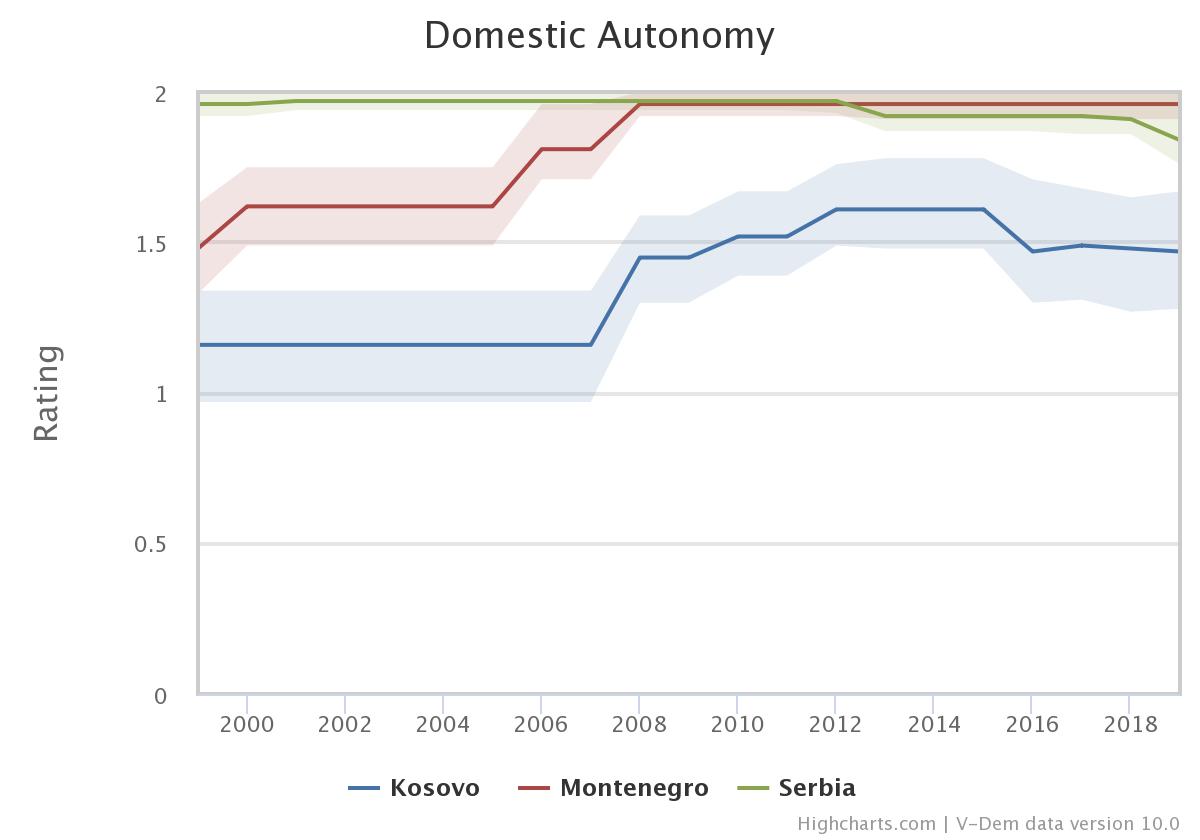Kosovo’s Ongoing Struggle for Domestic Autonomy
By: Lydia Finzel
Jun 08, 2020
On the 10 June 1999, the UN Security Council adopted the resolution 1244, effectively ending the war in Kosovo. Today, Kosovo remains a disputed territory, recognized as sovereign by 97 countries, but still claimed by Serbia. With these challenges in mind, this week’s graph focuses on domestic autonomy of the Kosovo and former Federal Republic of Yugoslavia, made up of the present-day independent countries of Serbia and Montenegro.
Kosovo is characterized by strong ethnic divisions. Many ethnic Serbs view Kosovo as part of their homeland due to historical and religious events, although around 90% of Kosovo‘s population is ethnic Albanian. Thus, both ethnic groups have reasons to believe Kosovo should belong to them. However, throughout the last century, the Serbian government suppressed ethnic Albanians by not giving them proper access to jobs or education.
These tensions resulted in a violent conflict between the Federal Republic of Yugoslavia and the Albanian rebel group, the Kosovo Liberation Army, from February 1998 to June 1999. Throughout the war, forces from Yugoslavia were accused of rape, murder, and ethnic cleansing, prompting a NATO intervention and UN peacekeeping mission. These crimes were later upheld by the International Criminal Tribunal for the Former Yugoslavia (ICTY), with the prosecution of former President Slobodan Milošević and his associates. Milošević died in custody before sentencing.
Domestic autonomy measures a state’s ability to conduct domestic policy without the control of other states. The variable ranges from 0 to 2 with higher values indicating higher level of autonomy.
The graph, starting after the Kosovo War, reveals that Kosovo’s autonomy still falls behind the autonomy of the former Federal Republic of Yugoslavia. The strong increase in Kosovo’s autonomy from a value of 1.16 in 2007 to 1.45 in 2008 corresponds with Kosovo’s declaration of independence from Serbia. Although not recognized by Serbia, major European powers and the United States have acknowledged Kosovo as an independent state. An agreement between the governments of Kosovo and Serbia signed in 2013 allows for autonomy of the Serb-majority parts of northern Kosovo and also ensures the two countries will not block each other’s efforts to seek EU membership. As a result, Kosovo achieved it’s highest value on domestic autonomy between 2012 and 2015.
Recently, Kosovo and Serbia have both seen declines in domestic autonomy, indicating that the fight for control of the region on both sides will continue. With a current value of 1.47, domestic autonomy in Kosovo is comparable low. The Serbian government still constrains the ability of domestic Kosovar actors to rule over their territory.
Interested in creating own graphs? Visit v-dem.net to experience one of our various graphing tools by yourself.


